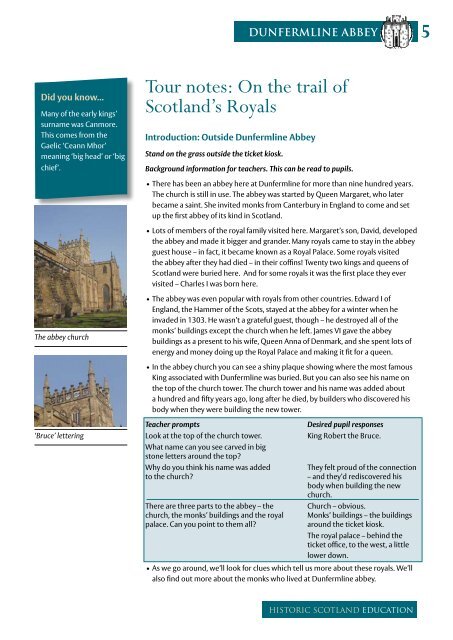Investigating - Dunfermline Abbey - Historic Scotland
Investigating - Dunfermline Abbey - Historic Scotland
Investigating - Dunfermline Abbey - Historic Scotland
Create successful ePaper yourself
Turn your PDF publications into a flip-book with our unique Google optimized e-Paper software.
DUNFERMLINE ABBEY<br />
5<br />
Did you know...<br />
Many of the early kings’<br />
surname was Canmore.<br />
This comes from the<br />
Gaelic ‘Ceann Mhor’<br />
meaning ‘big head’ or ‘big<br />
chief’.<br />
Tour notes: On the trail of<br />
<strong>Scotland</strong>’s Royals<br />
Introduction: Outside <strong>Dunfermline</strong> <strong>Abbey</strong><br />
Stand on the grass outside the ticket kiosk.<br />
Background information for teachers. This can be read to pupils.<br />
• There has been an abbey here at <strong>Dunfermline</strong> for more than nine hundred years.<br />
The church is still in use. The abbey was started by Queen Margaret, who later<br />
became a saint. She invited monks from Canterbury in England to come and set<br />
up the first abbey of its kind in <strong>Scotland</strong>.<br />
• Lots of members of the royal family visited here. Margaret’s son, David, developed<br />
the abbey and made it bigger and grander. Many royals came to stay in the abbey<br />
guest house – in fact, it became known as a Royal Palace. Some royals visited<br />
the abbey after they had died – in their coffins! Twenty two kings and queens of<br />
<strong>Scotland</strong> were buried here. And for some royals it was the first place they ever<br />
visited – Charles I was born here.<br />
The abbey church<br />
• The abbey was even popular with royals from other countries. Edward I of<br />
England, the Hammer of the Scots, stayed at the abbey for a winter when he<br />
invaded in 1303. He wasn’t a grateful guest, though – he destroyed all of the<br />
monks’ buildings except the church when he left. James VI gave the abbey<br />
buildings as a present to his wife, Queen Anna of Denmark, and she spent lots of<br />
energy and money doing up the Royal Palace and making it fit for a queen.<br />
• In the abbey church you can see a shiny plaque showing where the most famous<br />
King associated with <strong>Dunfermline</strong> was buried. But you can also see his name on<br />
the top of the church tower. The church tower and his name was added about<br />
a hundred and fifty years ago, long after he died, by builders who discovered his<br />
body when they were building the new tower.<br />
‘Bruce’ lettering<br />
Teacher prompts<br />
Look at the top of the church tower.<br />
What name can you see carved in big<br />
stone letters around the top?<br />
Why do you think his name was added<br />
to the church?<br />
There are three parts to the abbey – the<br />
church, the monks’ buildings and the royal<br />
palace. Can you point to them all?<br />
Desired pupil responses<br />
King Robert the Bruce.<br />
They felt proud of the connection<br />
– and they’d rediscovered his<br />
body when building the new<br />
church.<br />
Church – obvious.<br />
Monks’ buildings – the buildings<br />
around the ticket kiosk.<br />
The royal palace – behind the<br />
ticket office, to the west, a little<br />
lower down.<br />
• As we go around, we’ll look for clues which tell us more about these royals. We’ll<br />
also find out more about the monks who lived at <strong>Dunfermline</strong> abbey.<br />
HISTORIC SCOTLAND education













![Elgin Cathedral Wedding Brochure [pdf, 544kb] - Historic Scotland](https://img.yumpu.com/22301571/1/190x151/elgin-cathedral-wedding-brochure-pdf-544kb-historic-scotland.jpg?quality=85)



